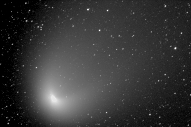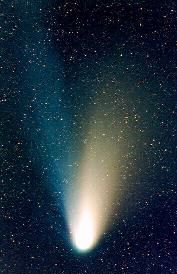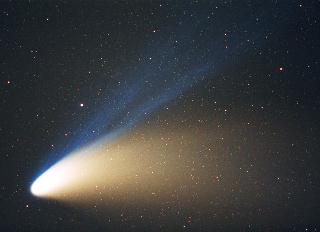
Observer: Stephane Potvin
Location: St-luc Dorchester, Quebec, Canada
Date: February 4, 1997 09:14 UT
150mm f/5 Astro-Physics refractor, SBIG ST-7 CCD camera.
The image has been flat fielded, log scaleded, and sharpened.


Observer: Stephane Potvin
Location: St-luc Dorchester, Quebec, Canada
Date: February 4, 1997 09:14 UT
150mm f/5 Astro-Physics refractor, SBIG ST-7 CCD camera.
The image has been flat fielded, log scaleded, and sharpened.

Observer: Ian Griffin
Location: Astronaut Memorial Planetarium & Observatory, Cocoa, Florida
Date: February 22, 1997 09:47:39 UT
12" f/5 Maksutov telescope, SBIG ST-8 CCD camera, 300 sec. exposure.
This image was taken through a Lumicon Swann Band filter. The original grey
scale image has been coloured to show detail.
Field of view is approximately 0.3 degrees (long R.A. axis) by 0.2 degrees
(short Declination axis).

Observer: Alessandro Dimai
Location: Col Druscie Observatory, Cortina d'Ampezzo, Italy
Date: February 28, 1997
Takahashi 102 mm f/6, Kodak Express Gold 400 II hypered, 4 min. exposure.
The comet was of magnitude 0.2 with a naked eye visible ion tail of ~10
degrees and a diffuse dust tail of ~5 degrees, despite the Moon that was in
the sky.
Copyright Associazione Astronomica Cortina
http://www.sunrise.associazioni/aac

Observer: Jarle Aasland
Location: Outside of Stavanger, Norway
Latitude: 58° 58' 12" North, Longitude: 5° 45' 0" East.
Date: March 14, 1997 01:15 UT
Unguided Nikon F4, 50mm f/1.8 lens, Fujicolor Super G Plus 800 ISO,
30 sec. at f/1.8 exposure.
Rocks in the foreground were lighted for about one second by car lights.
Sky conditions were almost perfect, although at this time some haze started
to appear (as you may see on the photo).
This and some other images can be found on
Jarle Aasland's Hale-Bopp webpage

Observer: David Hanon
Location: Soddy-Daisy, Tennessee, USA
Latitude: 35° North, Longitude: 85° West (approx.).
Date: April 10, 1997 02:05 UT
The image is a 1 minute exposure on Kodak PPF 400 film with a 300mm f/2.8 lens.
The image was taken near Soddy-Daisy, TN at 02:05 UT on 04/10/97.
Striations in the gas tail have become very prominent.
You can see the full-size original images at the
Comet Hale-Bopp Home Page
by Ron Baalke (JPL).
Excerpts from the Information on Comet Hale-Bopp for the Non-Astronomer
Charles S. Morris, JPL
The comet reaches its closest point to the Sun (perihelion) on April 1, 1997. At that time, it will be about 0.914 astronomical units from the Sun (one AU = about 93 million miles or 150 million kilometers -- the distance between the Sun and the Earth) or roughly 85 million miles (138 million kilometers) from the Sun. This is not a particularly close approach to the Sun. Some comets, like Comet Ikeya-Seki in 1965, have literally skimmed the surface of the Sun (and others have actually gone right into the Sun). Nonetheless, any comet that comes within 1 AU of the Sun has a chance to put on a nice show.
It has been suggested by some people that this comet may pose a threat to the Earth ...
This comet will NOT hit the Earth.
The comet will make its closest approach to the Earth on March 23, 1997. At that time, the comet will be more than 120 million miles (194 million kilometers) from Earth -- not even a very close approach! Will the comet "cross" the Earth's orbit? Well, yes and no ... the comet will come closer to the Sun than the Earth, but it will never actually physically cross any point in space that can be occupied by the Earth -- it can't hit the Earth!
Its orbit is inclined nearly 90 degrees from the ecliptic (the plane of our Solar System in which the planets orbit). The comet will come up from the south, go over the top of the Sun and then plunge down again. This means that the comet will be best seen from the Southern Hemisphere (and lower Northern latitudes) EXCEPT when it is expected to be at its brightest. In March and April 1997, it will only be easily visible from the Northern Hemisphere.
December 1995 - February 1996: In conjunction with the Sun (too close to the Sun to see).
March 1996 - July 1996: Comet visible in small telescopes and binoculars.
August 1996: Experienced observers detect the comet faintly with the naked eye. Easy object in binoculars.
September - November 1996: Comet brightens slowly as it moves northward and toward the Sun. Might be sighted by general public with assistance from experienced observer.
December 1996 - January 1997: Comet brightens rapidly, but comet is within 38 degrees of the Sun. Difficult object for general public because it will be very low in the sky when visible.
February - early March 1997: Comet remains low, but has become a bright object. It should be easy to find given reasonable instructions.
Late March - early April 1997: Comet should be at its best. It is expected to be near its peak brightness, and is at its farthest declination north. The best dates for observing the comet should be March 26 - April 12. During this period the Moon will not interfere (significantly). The comet will be in the northwest after sunset.
How high in the sky will the comet be?
Latitude........................................
Elevation at the End of Astronomical Twilight (April 10, 1997)
54-58 degrees...............................21 degrees
50 degrees....................................22 degrees
40-45 degrees...............................21 degrees
35 degrees....................................20 degrees
30 degrees....................................19 degrees
20 degrees....................................16 degrees
The effect of latitude is not significant until one approaches the equator. However, observers in higher latitudes will have one big advantage ... the comet will stay above the horizon longer. In fact, the comet will be circumpolar (above the horizon all the time) for observers at latitudes at or above 45 degrees North.
Late April - June 1997: In late April, the Moon will interfere. Comet will move south and closer (in the sky) to the Sun. It will also fade significantly, but the tail development should peak in May or June. It will be lost by the general public in the Sun's glare. Experienced observers might be able to follow it.
July - September 1997: Moves away from (but is still close to) the Sun in the morning sky. Comet is moving rapidly towards the south and continues to fade. Northern Hemisphere observers lose the comet during this period.
October - December 1997: Comet is lost from naked eye visibility. (It may be lost earlier due to its location close to the Sun). Comet continues to be a binocular object for Southern Hemisphere observers.
A wonderful collection of images has also been compiled by Ron Baalke (JPL).
Hale-Bopp Observations with Hubble and IUE Surprise Astronomers (Hubblesite, March 27, 1997)
Ron Baalke's (JPL) comprehensive list of links to other Hale-Bopp Pages
Harvard-Smithsonian Center for Astrophysics Press Information Sheet: Comet C/1995 O1 (Hale-Bopp)
Sky & Telescope has an excellent page on Hale-Bopp that includes plots of the comet's relative location above the horizon in 1997
Comet Observation Page (JPL, Charles S. Morris)
Comet Definitions (JPL, Charles S. Morris)
Recent News and Observations (JPL, Charles S. Morris)
Additional observations through March 3, 1997 have been used to update the orbit, ephemeris, and error analysis.
Epoch of elements: (J2000) 2,450,571.50000 = 1997 May 3.00000
Date of Perihelion Passage Tp: 2,450,539.6384314 (1997 Apr 1.13843)
Perihelion Distance q (AU): 0.914117707
Eccentricity e: 0.995103273
Argument of Perihelion ĝ [w]: 130.5909555°
Longitude of Ascending Node Ĝ [W]: 282.4708087°
Orbit Inclination i: 89.42965142°
Argument of Perihelion ĝ, Longitude of Ascending Node Ĝ, and Orbit Inclination i, are angles that describe the orientation of the comet's orbit to the plane of earth's orbit.
Original and Future Orbital Periods:
By integrating the above orbit forward and backward in time until the comet leaves the planetary system and then referring the osculating orbital elements to the Solar System barycenter, the following orbital periods result:
Original orbital period before entering planetary system = 4,200 years
Future orbital period after exiting planetary system = 2,380 years
The difference between the inbound and outbound orbital periods is due primarily to an approach to Jupiter (0.77 AU) in April 1996.
Ephemeris (with perturbations) for comet Hale-Bopp (1995 O1):
JPL Ref. Orbit 55 by D.K. Yeomans, Mar. 4, 1997
Ephemeris data at 1 day steps (0 hours UTC)
Date (UT) R.A. J2000 Dec. Delta Deldot r Theta Beta Moon PsAng PsAMV TMag 1997 Mar 30 01 28 43.92 +45 10 57.8 1.338 10.20 .915 43.1 48.3 128 20.0 289.4 -.1 1997 Mar 31 01 38 12.12 +44 53 34.6 1.344 11.46 .914 42.9 48.0 120 22.3 291.7 .0 1997 Apr 1 01 47 28.35 +44 33 21.4 1.351 12.68 .914 42.6 47.7 111 24.6 293.9 .0 1997 Apr 2 01 56 31.49 +44 10 28.9 1.359 13.86 .914 42.3 47.4 101 26.9 296.1 .0 1997 Apr 3 02 05 20.64 +43 45 08.5 1.367 15.01 .915 42.0 47.0 91 29.1 298.2 .0 1997 Apr 4 02 13 55.10 +43 17 31.9 1.376 16.11 .916 41.7 46.6 80 31.3 300.3 .0 1997 Apr 5 02 22 14.34 +42 47 51.2 1.385 17.16 .917 41.4 46.2 69 33.4 302.3 .0 1997 Apr 6 02 30 18.03 +42 16 18.2 1.396 18.17 .918 41.1 45.7 57 35.5 304.2 .0 1997 Apr 7 02 38 06.00 +41 43 04.8 1.406 19.14 .920 40.7 45.2 46 37.6 306.1 .1R.A. J2000 Dec. = Geocentric astrometric right ascension and declination referred to the mean equator and equinox of J2000. Light time corrections have been applied.
![]() This page was updated in: Abril 13 '97 and October 1, 2012
This page was updated in: Abril 13 '97 and October 1, 2012
Back to: ARVAL Gallery (Comet 1995 O1 Hale-Bopp)
Spanish: Cometa 1995 O1 Hale-Bopp
Messages: